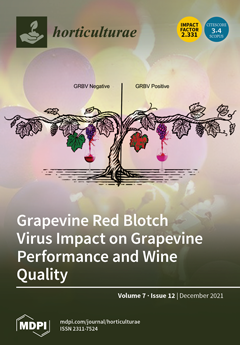Grape production in southern China suffers great loss due to various environmental stresses. To understand the mechanism of how the grape plants respond to these stresses is an active area of research in developing cultivation techniques. Plant stress resistance is known to rely on special proteins. Amongst them, DnaJ protein (HSP40) serves as co-chaperones of HSP70, playing crucial roles in various stress response. However, the DnaJ proteins encoded by the
DnaJ gene family in
Vitis vinifera L. have not been fully described yet. In this study, we identified 78
VvDnaJs in the grape genome that can be classified into three groups—namely, DJA, DJB, and DJC. To reveal the evolutionary and stress response mechanisms for the
VvDnaJ gene family, their evolutionary and expression patterns were analyzed using the bioinformatic approach and qRT-PCR. We found that the members in the same group exhibited a similar gene structure and protein domain organization. Gene duplication analysis demonstrated that segmental and tandem duplication may not be the dominant pathway of gene expansion in the
VvDnaJ gene family. Codon usage pattern analysis showed that the codon usage pattern of
VvDnaJs differs obviously from the monocotyledon counterparts. Tissue-specific analysis revealed that 12
VvDnaJs present a distinct expression profile, implying their distinct roles in various tissues.
Cis-acting element analysis showed that almost all
VvDnaJs contained the elements responsive to either hormones or stresses. Therefore, the expression levels of
VvDnaJs subjected to exogenous hormone applications and stress treatments were determined, and we found that
VvDnaJs were sensitive to hormone treatments and shade, salt, and heat stresses, especially VIT_00s0324g00040. The findings of this study could provide comprehensive information for the further investigation on the genetics and protein functions of the
DnaJ gene family in grape.
Full article





